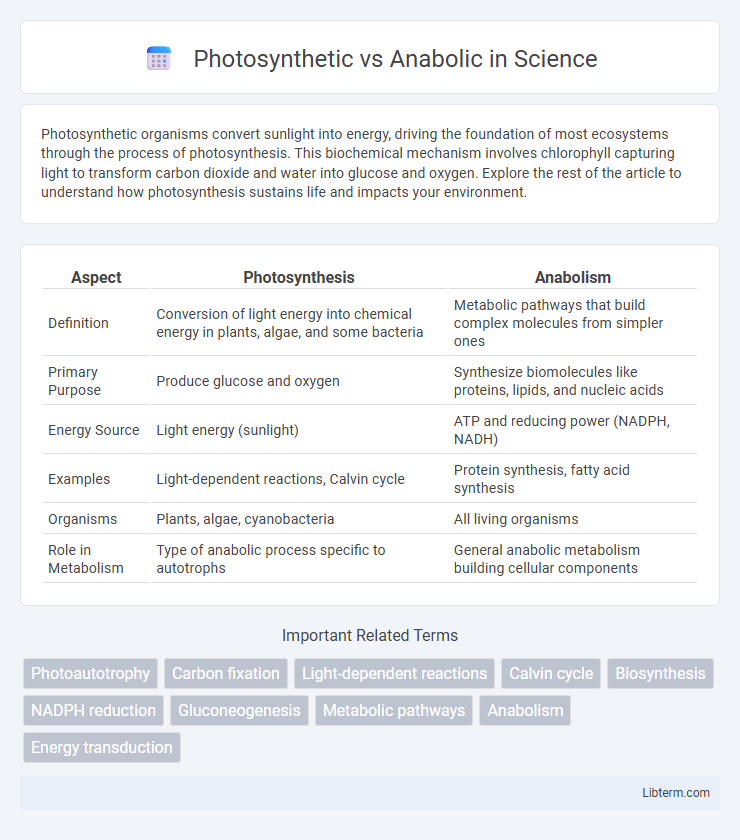Photosynthetic organisms convert sunlight into energy, driving the foundation of most ecosystems through the process of photosynthesis. This biochemical mechanism involves chlorophyll capturing light to transform carbon dioxide and water into glucose and oxygen. Explore the rest of the article to understand how photosynthesis sustains life and impacts your environment.
Table of Comparison
| Aspect | Photosynthesis | Anabolism |
|---|---|---|
| Definition | Conversion of light energy into chemical energy in plants, algae, and some bacteria | Metabolic pathways that build complex molecules from simpler ones |
| Primary Purpose | Produce glucose and oxygen | Synthesize biomolecules like proteins, lipids, and nucleic acids |
| Energy Source | Light energy (sunlight) | ATP and reducing power (NADPH, NADH) |
| Examples | Light-dependent reactions, Calvin cycle | Protein synthesis, fatty acid synthesis |
| Organisms | Plants, algae, cyanobacteria | All living organisms |
| Role in Metabolism | Type of anabolic process specific to autotrophs | General anabolic metabolism building cellular components |
Introduction to Photosynthetic and Anabolic Processes
Photosynthetic processes involve the conversion of light energy into chemical energy by chlorophyll-containing organisms, primarily through the light-dependent reactions and the Calvin cycle, producing glucose and oxygen as key outputs. Anabolic processes encompass a series of metabolic pathways that construct complex molecules such as proteins, nucleic acids, and lipids from simpler substrates, requiring energy input often derived from ATP. Both photosynthesis and anabolism are fundamental to cellular growth and energy storage, with photosynthesis providing the organic molecules used as building blocks in anabolic reactions.
Defining Photosynthesis: The Basics
Photosynthesis is a biochemical process in which green plants, algae, and certain bacteria convert light energy into chemical energy stored in glucose molecules. This process involves the absorption of sunlight by chlorophyll pigments, facilitating the transformation of carbon dioxide and water into oxygen and glucose. Unlike anabolic pathways that synthesize complex molecules from simpler ones using energy, photosynthesis specifically harnesses solar energy to drive the production of organic compounds essential for cellular metabolism and growth.
Understanding Anabolic Pathways
Anabolic pathways are crucial metabolic processes that build complex molecules from simpler ones, requiring energy input, typically in the form of ATP. These pathways include the synthesis of proteins from amino acids, nucleic acids from nucleotides, and lipids from acetyl-CoA, playing a fundamental role in cell growth and repair. Unlike photosynthetic processes that convert light energy into chemical energy, anabolic pathways focus on constructing essential biomolecules necessary for organism development and maintenance.
Key Differences Between Photosynthetic and Anabolic Reactions
Photosynthetic reactions involve converting light energy into chemical energy, primarily producing glucose and oxygen through carbon fixation in chloroplasts. Anabolic reactions are biosynthetic processes that consume energy to build complex molecules such as proteins, nucleic acids, and lipids from simpler precursors. Photosynthesis is a specific anabolic process focused on energy capture and storage, while anabolic reactions encompass a broader range of cellular synthesis activities essential for growth and repair.
Main Functions in Living Organisms
Photosynthesis primarily converts light energy into chemical energy, producing glucose and oxygen essential for plant and certain microbial life. Anabolic processes utilize energy to synthesize complex molecules like proteins, nucleic acids, and lipids required for cellular growth and repair. Together, photosynthesis provides the energy foundation, while anabolism supports structural and functional biomolecule formation in living organisms.
Biochemical Mechanisms: Light vs. Chemical Energy
Photosynthesis harnesses light energy via chlorophyll to drive the light-dependent reactions, producing ATP and NADPH used in the Calvin cycle for organic molecule synthesis. Anabolic pathways utilize chemical energy from ATP hydrolysis to assemble complex molecules from simpler precursors through enzyme-catalyzed reactions. The key biochemical distinction lies in photosynthesis converting solar energy into chemical energy, while general anabolism relies on pre-existing chemical energy sources to fuel biosynthetic processes.
Major Examples in Plants and Animals
Photosynthetic processes in plants, such as chlorophyll-driven photosynthesis in algae and higher plants, convert sunlight into chemical energy, producing glucose and oxygen. Anabolic pathways in animals, including protein synthesis and glycogen formation, build complex molecules from simpler ones to support growth and repair. Major examples highlight photosynthesis in plants like maize and oak, while anabolism is exemplified by muscle growth in mammals and shell formation in mollusks.
Importance in Energy Transformation
Photosynthetic processes capture solar energy, converting light into chemical energy stored in glucose, which forms the foundation of energy flow in ecosystems. Anabolic pathways utilize this stored chemical energy to synthesize complex molecules essential for cell growth and repair, driving biological functions. The interplay between photosynthesis and anabolism is crucial for maintaining energy balance and supporting life's metabolic demands.
Role in Growth and Metabolism
Photosynthetic processes convert light energy into chemical energy, producing glucose essential for cellular growth and metabolic activities in autotrophs. Anabolic pathways utilize this glucose and other precursors to synthesize complex molecules like proteins, nucleic acids, and lipids, driving cell development and maintenance. Together, photosynthesis supplies the energy and raw materials, while anabolism builds structural and functional biomolecules necessary for organismal growth and metabolism.
Comparative Summary and Future Perspectives
Photosynthetic processes convert light energy into chemical energy by synthesizing organic compounds from carbon dioxide and water, whereas anabolic pathways build complex molecules from simpler ones using energy derived from various sources including ATP. Photosynthesis primarily supports autotrophic growth and global carbon fixation, while anabolic reactions underpin cellular repair, growth, and metabolism across all organisms. Future advancements in synthetic biology and metabolic engineering aim to enhance photosynthetic efficiency and tailor anabolic pathways for sustainable biofuel production and novel bioproduct synthesis.
Photosynthetic Infographic

 libterm.com
libterm.com